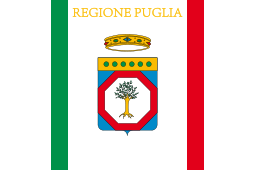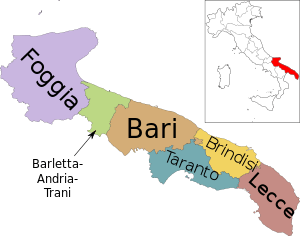Politics of Apulia
The Politics of Apulia, Italy, takes place in a framework of a presidential representative democracy, whereby the President of Regional Government is the head of government, and of a pluriform multi-party system. Executive power is exercised by the Regional Government. Legislative power is vested in both the government and the Regional Council.
 |
|---|
| This article is part of a series on the politics and government of Apulia |
|
Executive branch
The Regional Government (Giunta Regionale) is presided by the President of the Region (Presidente della Regione), who is elected for a five-year term, and is composed by the President and the Ministers (Assessori), who are currently ten.[1]
List of Presidents
Legislative branch
The Regional Council of Apulia (Consiglio Regionale della Puglia) is composed of 70 members and is elected with proportional representation plus a majority premium for the winning coalition.[2] The Council is elected for a five-year term, but, if the President suffers a vote of no confidence, resigns or dies, under the simul stabunt vel simul cadent clause (introduced in 1999), also the Council will be dissolved and there will be a fresh election.[3]
Local government
Provinces and Metropolitan City

Apulia is divided into five provinces and one metropolitan city:
| Province / Metropolitan City | Inhabitants | President | Party | Election | |
|---|---|---|---|---|---|
| Metropolitan City of Bari | 1,261,954 | Antonio Decaro | Democratic Party | 2015 | |
| Province of Barletta-Andria-Trani | 384,293 | Bernardo Lodispoto | Independent (centre-left) | 2019 | |
| Province of Brindisi | 401,652 | Riccardo Rossi | Independent (centre-left) | 2018 | |
| Province of Foggia | 627,102 | Nicola Gatta | Independent (centre-right) | 2018 | |
| Province of Lecce | 802,807 | Stefano Minerva | Democratic Party | 2018 | |
| Province of Taranto | 581,092 | Giovanni Gugliotti | Forza Italia | 2018 | |
Municipalities
Apulia is also divided into 258 comuni (municipalities), which have even more history, having been established in the Middle Ages when they were the main places of government. There are eight provincial capital cities in Apulia, as the Province of Barletta-Andria-Trani is the only province in Italy with three capital cities.
There are 258 communes in Apulia (as of January 2019):
- 41 in the Metropolitan City of Bari
- 10 in the Province of Barletta-Andria-Trani
- 20 in the Province of Brindisi
- 61 in the Province of Foggia
- 97 in the Province of Lecce
- 29 in the Province of Taranto
Provincial capitals
| Municipality | Inhabitants | Mayor | Party | Election | |
|---|---|---|---|---|---|
| Andria | 100,357 | Nicola Giorgino[4] | Forza Italia | 2015 | |
| Bari | 311,997 | Antonio Decaro | Democratic Party | 2019 | |
| Barletta | 94,664 | Cosimo Cannito | Independent (centre-right) | 2018 | |
| Brindisi | 88,482 | Riccardo Rossi | Independent (centre-left) | 2018 | |
| Foggia | 152,700 | Franco Landella | Forza Italia | 2019 | |
| Lecce | 89,902 | Carlo Salvemini | Independent (centre-left) | 2019 | |
| Taranto | 198,083 | Rinaldo Melucci | Democratic Party | 2017 | |
| Trani | 55,808 | Amedeo Bottaro | Democratic Party | 2015 | |
Other municipalities with more than 50,000 inhabitants
| Municipality | Inhabitants | Mayor | Party | Election | |
|---|---|---|---|---|---|
| Altamura | 70,789 | Rosa Melodia | Independent (centre-left) | 2018 | |
| Molfetta | 60,272 | Tommaso Minervini | Democratic Party | 2017 | |
| Cerignola | 57,007 | Franco Metta | Civic List | 2015 | |
| Manfredonia | 56,318 | Angelo Riccardi | Civic List | 2015 | |
| Bitonto | 56,304 | Michele Abbaticchio | Italian Left | 2017 | |
| San Severo | 55,297 | Francesco Miglio | Democratic Party | 2019 | |
| Bisceglie | 54,847 | Vittorio Fata | Democratic Party | 2017 | |
Parties and elections
Latest regional election
In the latest regional election, which took place on 31 May 2015, Michele Emiliano of the Democratic Party was elected president by a landslide over a fragmented set of opponents. The Democrats were narrowly the largest party with 19.8% of the vote, but two lists named after Emiliano got an additional combined 14.0%.
 | |||||||||
| Candidates | Votes | % | Seats | Parties | Votes | % | Seats | ||
|---|---|---|---|---|---|---|---|---|---|
| Michele Emiliano | 793,831 | 47.12 | 1 | ||||||
| Democratic Party | 316,876 | 19.80 | 13 | ||||||
| Emiliano Mayor of Apulia (incl. SC, IdV, PdS) | 155,840 | 9.74 | 6 | ||||||
| Us on the Left for Apulia (incl. SEL) | 108,920 | 6.81 | 4 | ||||||
| Populars (incl. UdC, CD, RI) | 99,021 | 6.19 | 3 | ||||||
| Apulia for Emiliano | 68,366 | 4.27 | 3 | ||||||
| Communist Party of Italy | 10,398 | 0.65 | − | ||||||
| Pensioners and Disables | 6,712 | 0.42 | − | ||||||
| Populars for Italy | 6,575 | 0.41 | − | ||||||
| Total | 772,708 | 48.28 | 29 | ||||||
| Antonella Laricchia | 310,304 | 18.42 | 1 | Five Star Movement | 275,114 | 17.19 | 7 | ||
| Francesco Schittulli | 308,168 | 18.29 | – | ||||||
| Beyond with Fitto | 155,771 | 9.73 | 4 | ||||||
| Schittulli Political Movement – Popular Area | 101,817 | 6.36 | 4 | ||||||
| Brothers of Italy | 39,164 | 2.45 | – | ||||||
| Total | 296,752 | 18.54 | 8 | ||||||
| Adriana Poli Bortone | 242,641 | 14.40 | – | ||||||
| Forza Italia (incl. LAM) | 181,896 | 11.37 | 5 | ||||||
| Us with Salvini | 38,661 | 2.42 | − | ||||||
| National Apulia | 9,186 | 0.57 | − | ||||||
| Italian Liberal Party | 1,797 | 0.11 | − | ||||||
| Total | 231,540 | 14.47 | 5 | ||||||
| Riccardo Rossi | 17,110 | 1.02 | – | The Other Apulia (incl. PRC) | 14,513 | 0.91 | − | ||
| Gregorio Mariggiò | 7,559 | 0.45 | – | Federation of the Greens | 6,278 | 0.39 | − | ||
| Michele Rizzi | 5,056 | 0.30 | – | Communist Alternative Party | 3,414 | 0.21 | − | ||
| Total candidates | 1,684,669 | 100.00 | 2 | Total parties | 1,600,319 | 100.00 | 49 | ||
| Source: Ministry of the Interior – Historical Archive of Elections | |||||||||
References
- http://www.regione.puglia.it/index.php?page=struttura&opz=giunta&cust=1
- La Repubblica – Regional electoral law
- "Regional Council of Lombardy – 1999 Constitutional law" (PDF). Archived from the original (PDF) on 6 March 2009. Retrieved 6 March 2009.
- Removed from office on 29 April 2019.